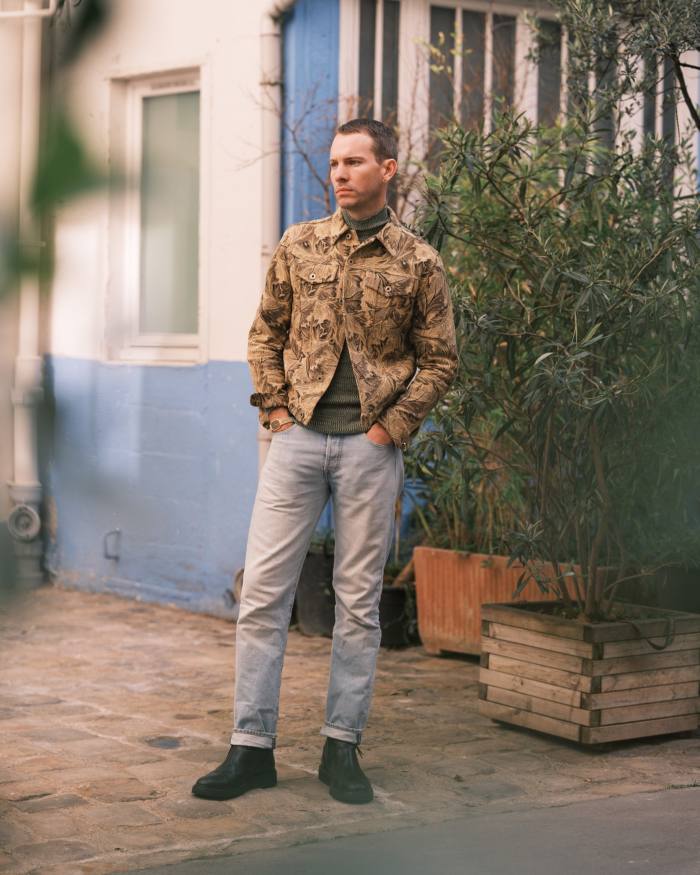The appeal of black is hard to resist. Even among the most fashionable gents, it has long been the standard go-to when it comes to expressing one’s elegance and masculine allure. It’s a stylistic rule that has been reinforced time and time again by waves of menswear designers, from Calvin Klein and Helmut Lang to Hedi Slimane and Raf Simons. But black can be a trap in more ways than one, for as much as it can be chic, it can also be an anonymous, tired cliché.
It took me some time to embrace colour, after a dark, near-gothic entry into the world of fashion through the music and nightlife culture of the early 2000s. As a magazine editor and fashion writer, I’ve been privy to the dressing habits of some of the world’s most fashionable men. These men integrate colour into their daily lives, and it can be a quiet joy to behold — from the flash of a silk foulard beneath a cashmere crewneck to the singular statement of a cosy coat in a vivid hue.
These days, I wear playful combinations of colours, patterns and materials in what I consider to be a relatively classic, quite often oversized silhouette. Yes, I work in a creative field, but my own shift mirrors the breakdown of sartorial expectations in the workplace. The rules of how and when to wear tailoring and streetwear have shifted, and today there is greater chromatic freedom in men’s wardrobes than in decades past.
The context of colour has changed too, as, for example, skate brands co-opt pastels; male celebrities such as Timothée Chalamet, Eddie Redmayne and Rami Malek wear bright, exuberant eveningwear on the red carpet; and the twee, generational connotations of preppy staples like “Nantucket reds” and pistachio-coloured chinos are revisited with both nostalgia and irony.

Add to that the crossover of heritage and streetwear brands from Palace and Ralph Lauren to Dries Van Noten and Stüssy, and you can clearly see how the rules have been bent beyond breaking point to allow all manner of fashionable shapes, silhouettes and materials to exist in a rainbow of colourful combinations.
Haider Ackermann and Pierpaolo Piccioli are the master colourists in my menswear pantheon. Men of their ilk twist the codes of subcultures and archetypes as they fancy, mixing and matching designer pieces with “uniform” staples, vintage finds and the most basic, classic layers imaginable. Though their respective collections might advocate head-to-toe chromatic statements and complex styling, their personal style tells another story. The former is a dab hand at cherry-picking a single statement piece from his archives (an emerald silk trouser perhaps, or a tobacco velvet topcoat) and mixing it with vintage tees and denim, while the latter adorns black, fluid basics with a lavish strand of coral beads.
Applying these ideas at home means playing to your strengths: matching eye colour or enhancing skin tone with contrasting shades (note to redheads: wear green!) and treading carefully around dull neutrals or cold pastels that wash out pale skin or emphasise redness. Wearing colours dissimilar from your skin tone is usually a safe rule. Colour-blocking is an effective statement too, dodging the need to create careful harmonies by choosing a single colour or tonal combination and running with it from head to toe — a simpler task than ever before thanks to the tendency of brands to offer deconstructed suit separates, shirt jackets and other casual pieces in matching fabrics.
Looking at the opposite ends of the colour wheel is often a good start if you are uncertain about mixing shades. If your winter coat is a dark navy, why not try a scarf or beanie in a brick orange or sunny yellow? Or contrast olive and khaki with bright red, pink or violet. Another trick I enjoy is a singular pop of colour within a monochrome outfit, twisting an otherwise banal ensemble with a yellow coat, burgundy boots or an emerald cardigan. Think about how a pair of bashed-up Levi’s will look different when they reveal cardinal red socks (I recommend the Pope’s preferred sock supplier: Gammarelli in Rome), or how a classic blazer is transformed when thrown over a turquoise T-shirt. If in doubt, just start with socks!
In the same sense, the update of classic designs in unconventional hues is exciting too, allowing shots of colour to play a part in even the most conventional silhouettes. In my closet, one go-to layer of colour is a short, pale green “jean” jacket in a William Morris tapestry fabric — it’s the most traditional, utilitarian shape but a guaranteed head-turner for its soft colour and dense leafy pattern. Likewise, I’ve amassed a collection of crewneck cotton tees in jewel tones such as cobalt blue, sea green and emerald, which form a bright base beneath shirting, knitwear and tailoring alike.
In the end, colour should be both fun and effortless — it’s a natural mood enhancer both for the wearer and those around them. When it comes to dress codes, sartorial taboos and archaic rules have been abolished in most spaces and communities, and that’s something to celebrate. Wear pink if you want to, or don’t. Let colour play to your individuality, mood and joie de vivre, as its codified links to gender, sexual preference or social status should be left defiantly in the past.
Find out about our latest stories first — follow @financialtimesfashion on Instagram
Stay connected with us on social media platform for instant update click here to join our Twitter, & Facebook
We are now on Telegram. Click here to join our channel (@TechiUpdate) and stay updated with the latest Technology headlines.
For all the latest Fashion News Click Here

